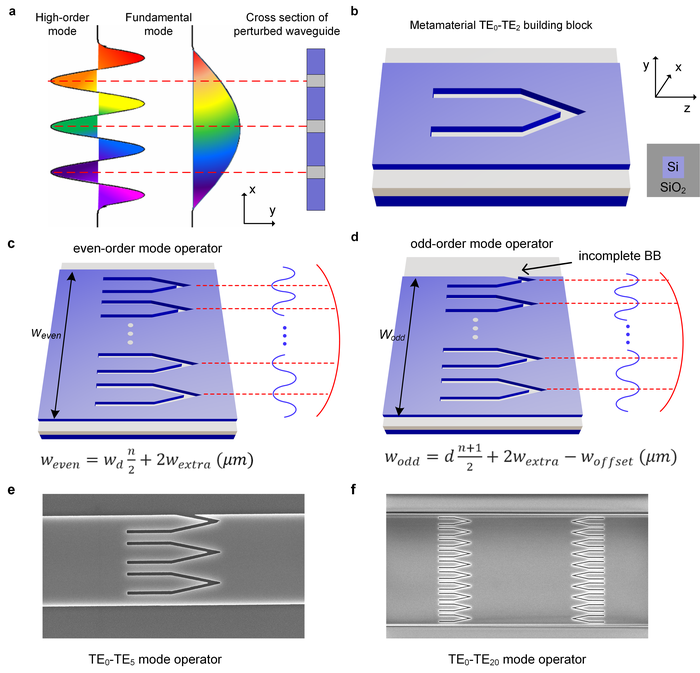With the fast expansion of the Internet of Things (IoT) and cloud computing, worldwide data traffic has grown at an exponential rate. Since optical communication systems are the critical components of the global communications infrastructure, they confront significant hurdles in addressing the impending “capacity crisis.”
 a, Dielectric perturbations are located at the “peaks” or “valleys” in the transverse mode profile of high-order mode to maximize the mode overlap integral. b, Schematic view of the metamaterial TE₀-TE₂ building block, exploiting fully-etched dielectric slots on a silicon waveguide. c-d, Topology layout of arbitrary even-order and odd-order mode operators, respectively. The waveguide width is directly determined by mathematical formulas for a given mode order. e-f, SEM photos of the TE₀-TE₅ and TE₀-TE₂₀ mode operators, respectively. Image Credit: Jinlong Xiang, Zhiyuan Tao, Xingfeng Li, Yaotian Zhao, Yu He, Xuhan Guo, and Yikai Su
a, Dielectric perturbations are located at the “peaks” or “valleys” in the transverse mode profile of high-order mode to maximize the mode overlap integral. b, Schematic view of the metamaterial TE₀-TE₂ building block, exploiting fully-etched dielectric slots on a silicon waveguide. c-d, Topology layout of arbitrary even-order and odd-order mode operators, respectively. The waveguide width is directly determined by mathematical formulas for a given mode order. e-f, SEM photos of the TE₀-TE₅ and TE₀-TE₂₀ mode operators, respectively. Image Credit: Jinlong Xiang, Zhiyuan Tao, Xingfeng Li, Yaotian Zhao, Yu He, Xuhan Guo, and Yikai Su
The mode-division multiplexing (MDM) technique was supposed to make the next significant leap in spectral efficiency, according to the photonic research community. Controlling as many spatial mode channels as feasible is becoming increasingly important in the upcoming era.
Traditional on-chip mode modification approaches, on the other hand, often use a mode-order focused design strategy, which ultimately results in a long development time and a high trial-and-test cost.
Furthermore, either the functioning principle or manufacturing processes limit the number of possible mode ordering. As a result, they are inefficient in numerous ways, from design complexity to device scalability.
Professor Xuhan Guo and Professor Yikai Su of Shanghai Jiao Tong University led a team of scientists that established a universal design framework for arbitrary on-chip spatial mode control based on the notion of metamaterial building blocks (BBs) in a recent research study published in Light Science & Application.
Arbitrary mode conversion and mode exchange can be done with a uniformly good performance by simply scripting the topological arrangement of BBs with specified mathematical formulas.
As a result, their metamaterial BBs enable the experiment for the first time with record high-order mode up to the 20th. An 8-mode photonic integrated circuit with an aggregate data throughput of 813 Gb/s was used as an experimental demonstration of the principle, demonstrating its great potential in high-capacity on-chip data transfer.
The method and technology described here can aid in the development of high-efficiency integrated photonic communication systems, as well as other sectors of information processing such as optical sensors and nonlinear and quantum photonics.
Comprehensively etched dielectric slots on a multimode silicon waveguide are used to create the metamaterial BB that supports TE0-TE2 mode conversion and mode exchange.
The metamaterial waveguide can manage arbitrary high-order guided modes effectively without any further optimization by programming a series of BBs in a parallel arrangement with pre-defined formulae.
The beam shaping principle provides a straightforward route to control arbitrary high-order modes, however, its great potential has been previously constrained by the complicated implementations of the traditional Mach-Zehnder interferometer architecture or other trail-and-test approaches for different modes.
Xuhan Guo, Professor, Shanghai Jiao Tong University
The team of scientists added, “We innovatively engineer dielectric slots, which can function as a power splitter and a phase shifter simultaneously, to realize the process of beam splitting, phase shifting, and beam combining within an ultra-compact conversion region. So the metamaterial BBs are placed to the regions where ‘peaks’ or ‘valleys’ are located in the transverse field profile of the high-order mode to maximize the mode overlap between involved modes.”
“By simple topological arrangement of the BBs using predefined mathematical formulas, arbitrary high-order mode can be effectively generated. We believe the presented generic mode manipulation approach represents critical progress towards advanced control of more physical dimensions of optic carriers,” further commented the team of scientists.
Along with this, they also stated, “More importantly, all necessary components for coherent communications have been demonstrated on integrated platforms so far including both coherent transmitters and receivers. The metamaterial BBs make it possible to efficiently manipulate record high-order modes in practice, therefore, it becomes extremely promising to obtain fully-integrated MDM communication systems of ultra-high spectral efficiency.”
The scientists outlined, “Hopefully, the novel concept of building blocks itself can be flexibly transferred to other waveguide platforms (InP, Si3N4, etc.) as well as other wavelength bands (O band, mid-infrared band, etc.). Besides, the fundamentals gained from our on-chip arbitrary spatial mode manipulation may provide inspirations to more versatile metamaterial-assisted building block designs and could open up fascinating opportunities for complex photonic functionalities previously inaccessible.”
Journal Reference:
Xiang, J, et al. (2022) Metamaterial-enabled arbitrary on-chip spatial mode manipulation. Light: Science & Applications. doi:10.1038/s41377-022-00859-9